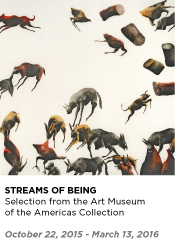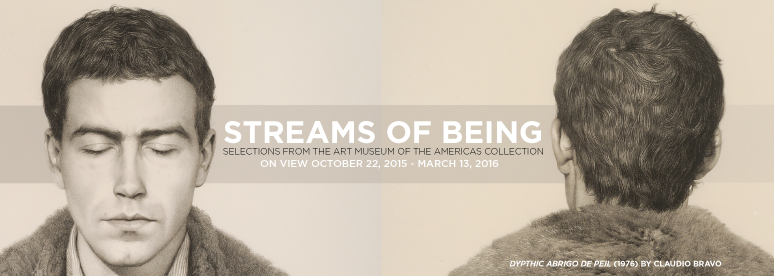
Streams of Being:
Selections from the Art Museum of the Americas
On view October 22, 2015- January 31, 2016
Opening Reception: October 22, 2015 at 6pm
ABOUT THE EXHIBITION
Drawn from the permanent collection of AMA | Art Museum of the Americas, Streams of Beings brings to light a multiplicity of ideas and identities emerging within contemporary Latin American art. Featuring twenty-two artists from twelve countries across the Americas, this exhibition explores the permeable boundaries and dimensions of life through interrelated themes of scale and place, human and animal bodies. Its dialogic structure emphasizes the myriad and active relationships between the objects on view and the wider world that they, and we, inhabit. Throughout four intersecting “streams”—Bestiary, Cosmos, Topologies, and Bodies in Exile—the exhibition stages movement and displacement, dwelling on crossings both serendipitous and transgressive in kind.
At a time when the mobility of artists and culture has never been greater, Streams of Being explores the constituting values of place and the experience of travels past, present, and future, whether in the mind’s eye or across the vast expanses of the Americas. Eschewing conventional organizational rubrics of medium, nationality, and chronology, this exhibition invites viewers to travel alongside the objects on view, embracing its logic of movement—against stasis—from inside to outside, self to other, homeland to diaspora. Arranged as a series of intercultural propositions, Streams of Being posits the museum itself as a formative site of encounter and, ultimately, of self-reflection.
Streams of Being developed out of a collaboration between AMA | Art Museum of the Americas and The Art Gallery at the University of Maryland. Graduate and undergraduate students in the university’s Department of Art History and Archaeology worked with Assistant Professor Abigail McEwen to organize this exhibition in 2014-15.
Bestiary
A panoply of beings spanning the animal and the human, the divine and the mundane, populates this visual Bestiary. This gallery meditates not only on our relationship to the nonhuman, but also on the nature of fantastical projection and the history of our own existence. Continuing age-old cycles of transformation and reproduction, these shape-shifting bodies betray a morphological consciousness that probes the boundaries of the modern self—animal, non-human, human—and the assimilating networks that define our shared world. In depictions of pregnant tapirs by Ruth Bess and of birds’ heads by Marcelo Grassmann, luxuriant fur coats by Claudio Bravo and silvery gossamers by Emilio Renart, Bestiary repeatedly asks what it means to be human—and animal.
Cosmos
Imagings of the cosmos elicit our sense of wonder at the immensity of the universe near and far, exciting the imagination as we contemplate the sources and possibilities of creation. The planetary consciousness of the Space Age surfaces in David Manzur’s telescopic Series of the Cosmos, which evolves from “Forms to Copy the Moon” to “Birds of the Moon,” “The Death of a Bird,” and finally “The Footsteps of a Planet.” Nearer at hand, the elemental physicality of the terrestrial world intertwines suggestively with the human body in the work of Carlos Alfonzo. Cataclysmic and cathartic flames splice through space in Fire, exploding through fragmented forms with vital, tumultuous energy. Together, these works remark upon the scales of human experience, staging our existential identity against the enormities of the universe.
Topologies
Against the rising hegemony of the United States over the twentieth century, calls for “nuestra América” responded to the relevance of inter-American identity—and solidarity—across national borders. Topologies speaks to the multiplex histories of individual and collective movement across the Americas, encompassing sites of memory (Domingo Batista) and cartographic abstractions (Gego), ecological trauma (Gesner Armand, Angu Vázquez), and architecture (Oscar Muñoz). This postcolonial condition is laden with the imprint of the body—fragmented and naked, x-rayed and indigenous—across the pages of Bernardo Krasniansky’s assemblaged book. From graveyard to island, the topologies of interior and exterior—here and there—converge in the untitled photograph by Víctor Vázquez, a haunting study of liminal, impossibly indeterminate space.
Bodies in Exile
An internal and an external state of being, a form of punishment and of displacement, exile is at once elusive and everywhere. Exile impinges upon our essential identities by force of geographic, and often psychic alienation. Somatic traces of homelessness and estrangement penetrate Mario Carreño’s elegy of part-bodies and Agustín Fernández’s eroticized flora, turning mechanical in the hyper-masculine automatons of Juan Downey and José Luis Cuevas. Anatomical metaphors continue through the parceling of the body into pieces: a single fingerprint (Liliana Porter), a disembodied foot (Ronnie Carrington). The complexities of psychological internment and neurosis resonate across works by Catalina Chervin and Ernesto Deira, rendering the “bodies of exile” through the cogitations and captivities of the mind.

